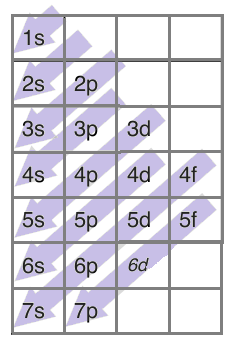
The electronic configuration of argon is:
[A] $1{{s}^{2}}2{{s}^{2}}2{{p}^{6}}3{{s}^{2}}3{{p}^{6}}$
[B] $1{{s}^{2}}2{{s}^{2}}2{{p}^{6}}3{{s}^{2}}3{{p}^{2}}$
[C] $1{{s}^{2}}2{{s}^{2}}2{{p}^{6}}3{{s}^{2}}3{{p}^{4}}$
[D] $1{{s}^{2}}2{{s}^{2}}2{{p}^{6}}3{{s}^{2}}3{{p}^{6}}3{{d}^{10}}4{{s}^{2}}4{{p}^{6}}$
Answer
571.2k+ views
Hint: The atomic number of argon is 18. We can write the electronic configuration by the help of the atomic number and filling up those electrons in s, p, d and f-orbitals. The number of electrons that can be accommodated in s, p, d and f-orbitals are 2, 6, 10 and 14 respectively.
Complete step by step answer:
We should know that electronic configuration of any atom or molecule gives us the numeric arrangement of electrons around the nucleus.
There are specific notations that we use for writing the configuration of any atom. For writing these notations, we start with the energy orbitals. Practically, there are 4 orbitals s, p, d and f. There is a certain even number of electrons that each orbital can accommodate. s-orbital can accommodate 2 electrons whereas p, d and f-orbitals can accommodate 6, 10 and 14 electrons respectively.
There is a trend each electron follows while filling these orbitals and it is given as-

For example, if there are 6 electrons in an element, two electrons will enter 1s orbital first followed by two electrons in 2s-orbital and then the remaining 2 in the 2p-orbital.
Similarly, we can write the electronic configuration for argon. The atomic number of argon is 18 which means it has 18 electrons and 18 protons. We can write the electronic configuration for 18 electrons following the above diagram as-$1{{s}^{2}}2{{s}^{2}}2{{p}^{6}}3{{s}^{2}}3{{p}^{6}}$.
Therefore, the correct answer is $1{{s}^{2}}2{{s}^{2}}2{{p}^{6}}3{{s}^{2}}3{{p}^{6}}$.
So, the correct answer is “Option A”.
Note: While writing electronic configuration, we need to consider three rules. They are- Aufbau principle, Hund’s rule and Pauli’s exclusion principle.
According to Aufbau’s principle, the added electron will always occupy the orbital in the lowest possible energy first and then go for higher energy orbitals in a systematic way.
According to Pauli’s exclusion principle, each orbital can hold a maximum of two electrons of opposite spin.
And according to Hund’s rule, while filling a sub-shell each orbital is occupied by electrons in the same spin and when it's filled up then the electrons take the opposite spin.
Complete step by step answer:
We should know that electronic configuration of any atom or molecule gives us the numeric arrangement of electrons around the nucleus.
There are specific notations that we use for writing the configuration of any atom. For writing these notations, we start with the energy orbitals. Practically, there are 4 orbitals s, p, d and f. There is a certain even number of electrons that each orbital can accommodate. s-orbital can accommodate 2 electrons whereas p, d and f-orbitals can accommodate 6, 10 and 14 electrons respectively.
There is a trend each electron follows while filling these orbitals and it is given as-

For example, if there are 6 electrons in an element, two electrons will enter 1s orbital first followed by two electrons in 2s-orbital and then the remaining 2 in the 2p-orbital.
Similarly, we can write the electronic configuration for argon. The atomic number of argon is 18 which means it has 18 electrons and 18 protons. We can write the electronic configuration for 18 electrons following the above diagram as-$1{{s}^{2}}2{{s}^{2}}2{{p}^{6}}3{{s}^{2}}3{{p}^{6}}$.
Therefore, the correct answer is $1{{s}^{2}}2{{s}^{2}}2{{p}^{6}}3{{s}^{2}}3{{p}^{6}}$.
So, the correct answer is “Option A”.
Note: While writing electronic configuration, we need to consider three rules. They are- Aufbau principle, Hund’s rule and Pauli’s exclusion principle.
According to Aufbau’s principle, the added electron will always occupy the orbital in the lowest possible energy first and then go for higher energy orbitals in a systematic way.
According to Pauli’s exclusion principle, each orbital can hold a maximum of two electrons of opposite spin.
And according to Hund’s rule, while filling a sub-shell each orbital is occupied by electrons in the same spin and when it's filled up then the electrons take the opposite spin.
Recently Updated Pages
Why are manures considered better than fertilizers class 11 biology CBSE

Find the coordinates of the midpoint of the line segment class 11 maths CBSE

Distinguish between static friction limiting friction class 11 physics CBSE

The Chairman of the constituent Assembly was A Jawaharlal class 11 social science CBSE

The first National Commission on Labour NCL submitted class 11 social science CBSE

Number of all subshell of n + l 7 is A 4 B 5 C 6 D class 11 chemistry CBSE

Trending doubts
10 examples of friction in our daily life

One Metric ton is equal to kg A 10000 B 1000 C 100 class 11 physics CBSE

Difference Between Prokaryotic Cells and Eukaryotic Cells

1 Quintal is equal to a 110 kg b 10 kg c 100kg d 1000 class 11 physics CBSE

State the laws of reflection of light

Explain zero factorial class 11 maths CBSE




